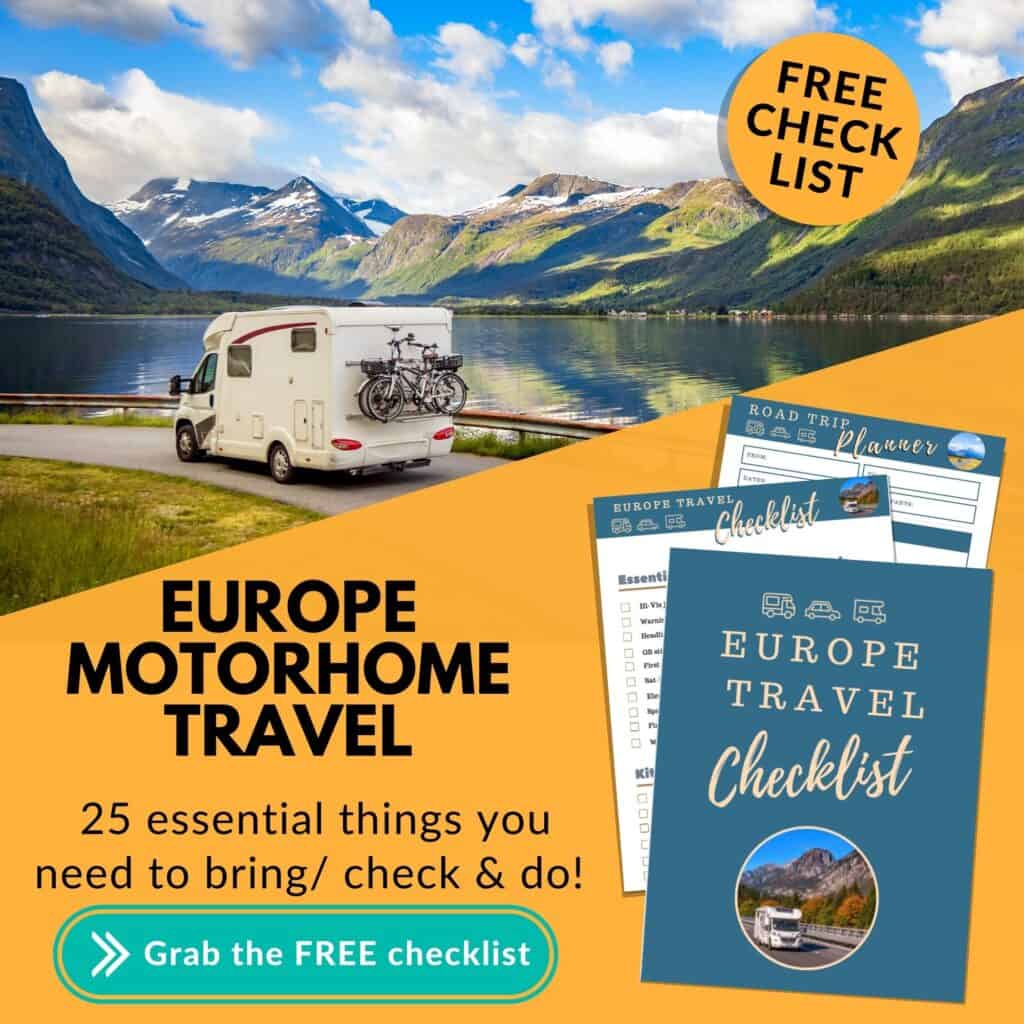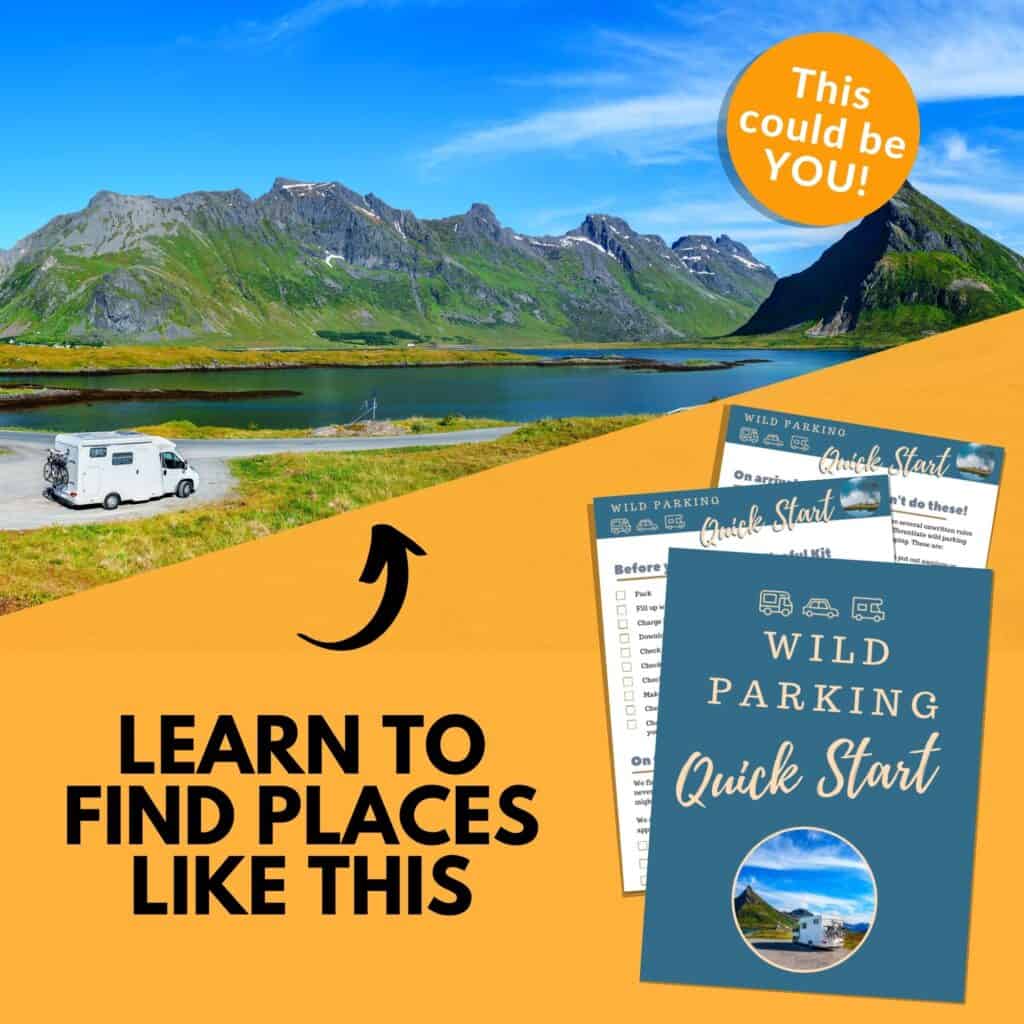Planning a motorhome or campervan trip to Norway? Want to see some of the most breathtaking places in Europe? Here’s everything you need to know to go campervanning or motorhoming in Norway, including routes and places to visit.
Don’t forget to download your FREE Europe motorhome travel checklist below to help you plan your Norway road trip.
*We work hard to make this the best motorhome blog and road trip website possible, full of helpful content for you. The website is supported by our readers, so if you buy through links on this site we may earn a commission- at no extra cost to you. All opinions remain our own.
If you find this post useful, you can also treat us to a coffee at the bottom of this page- we promise to enjoy it while creating more useful content like this- we might even indulge in a biscuit (or two!)
Motorhoming in Norway – why you should go!
If you want to take your motorhome to some of the most breathtaking scenery in the world (not just Europe), you have to find time to get to Norway.
Seriously, we’ve been touring Europe in a motorhome for years- and Norway still blew it all out of the water.
The fjords, the mountains, the glaciers- it’s just all… I run out of superlatives. And even better, they LOVE motorhomes and campervans. Wild camping is allowed pretty much anywhere and there are so many incredible places to stay- choosing is often the hardest part. Add in how friendly and welcoming the people are, and it’s pretty much the perfect motorhoming destination.
In this post, we’re going to share with you everything you need to know to go motorhoming or campervanning in Norway, including getting to Norway and planning your route, where to stay (motorhome campsites, aires or wild camping with your camper), some road trip itineraries and places to visit, driving tips and other practical advice to help you have an amazing Norwegian road trip. If you’d like to see our costs, you can read how expensive our road trip to Norway was here
If this is your first campervanning trip to Norway (or Europe!), don’t forget to grab your free motorhome travel checklist which will help you plan and organise everything you need.
Campervanning in Norway – Where to go
When planning a motorhome trip to Norway, the first thing you need to do is decide where you’re going (and how long you have for your adventure!)
How long to go for?
If you’re driving from the UK to Norway (we’ll cover that shortly), you need to allow at least 3 days to get from arriving in France (by either ferry or Eurotunnel) to get to the Norwegian border. And that’s 3 days of pretty much solid driving.
We don’t recommend visiting Norway if you only have a week or even 10 days for your road trip. It’s too far and all you’ll do is drive there and back. Of course, if you’re going to rent a motorhome and fly in, that’s perfectly doable in a week (more on that shortly).
If you have a couple of weeks, you can certainly explore some of the best places in Southern Norway, but again it will be a lot of driving. We went for 3 weeks, and we still didn’t get as far as we wanted to.
Map of our Norway Motorhome Tour
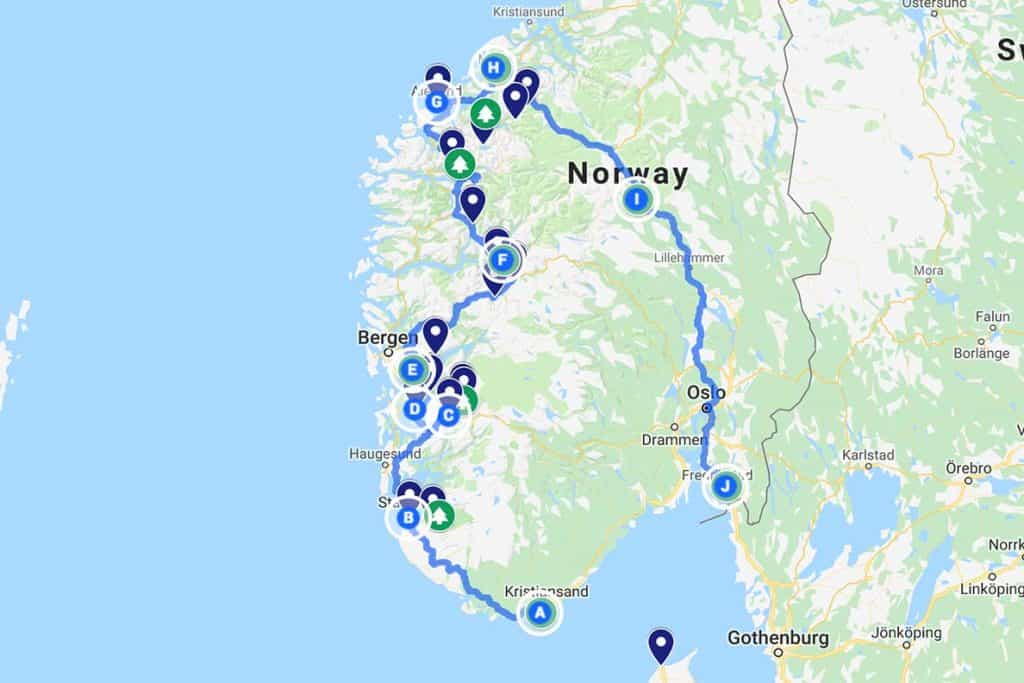
Don’t forget, the best roads are the coastal roads, but they are also the slowest roads. So ideally save your motorhome trip to Norway until you have a block of 3 or more weeks so you can really enjoy it.
Norway is the longest country in Europe, and it takes about 30 hours to drive from Kristiansand to Hammerfest in the north- if you go the direct roads down the middle (which is also the expensive toll road!) It took us 2 days to drive back from near Kristiansund to the Swedish border (route ‘I’)
Don’t overestimate how far you can travel in one day. The roads are much slower than you might be expecting- not helped by all the ferries between places. There are a lot of single track roads which will slow you down.
TOP TIP: If you’re trying to get to the north of Norway, go up through Sweden- the roads are faster and also toll-free.
Some of our favourite places in Norway
Here are some of the highlights from our time motorhoming in Norway (so far!)
See all our Norway tips and destinations here
The Visit Norway website is a wonderful resource for finding places to visit, plus motorhome services, petrol stations and other useful tips.
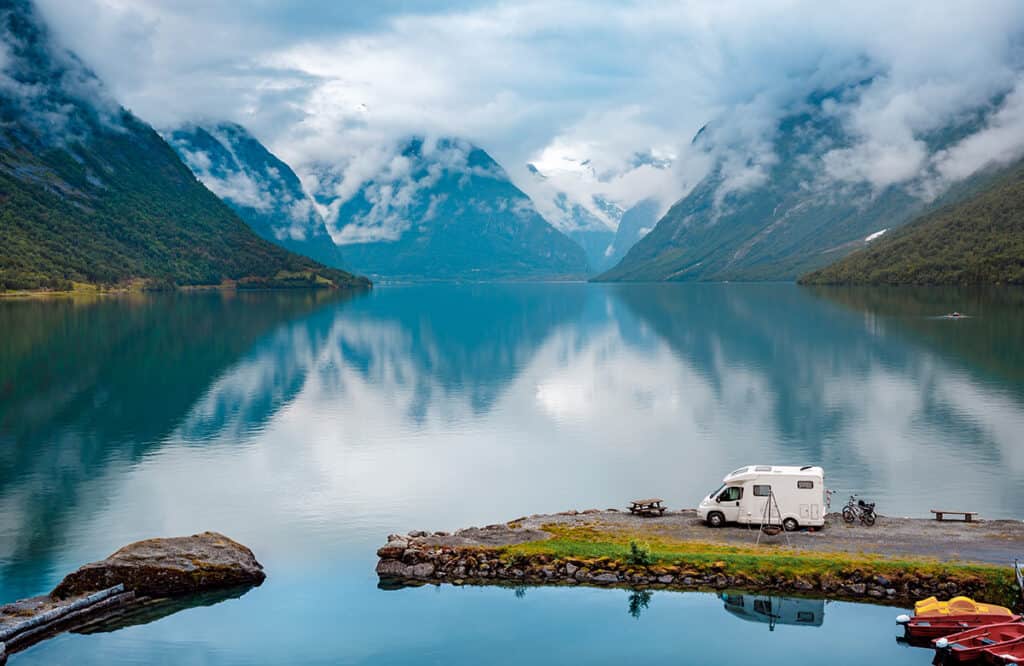
When to go motorhome touring in Norway
We have been to Norway several times- once with a motorhome, twice by air. We planned our motorhome trip in mid-July, and it rained solidly for 3 weeks (and yes, it was STILL one of the best motorhome trips we’ve done!)
We’ve also been in late November and early March, both times to see the Northern Lights (Norway is one of the best places in Europe to see the Northern Lights)
So, the answer on when is the best time depends on what you want to do. Norway only really has two seasons- summer and winter. Spring and Autumn do happen, but they are quick and unpredictable.
Norway in Winter
Norway is further North than Scotland, so expect snow- and a lot of it. It gets COLD in winter. Very very very cold. Anytime after October until early April is considered winter.
Also, don’t forget that Norway doesn’t get much sunlight in winter, and what it does get is pretty weak. So you don’t have as long during the ‘day’ to explore, even if you are happy to drive in the snow and ice. The main roads are kept pretty clear, but more remote areas might be impossible to access, even with winter tyres fitted on your van.
Visiting Norway in Summer
Summer is by far the best time for a road trip to Norway. The days are long, the weather is surprisingly warm and even though it rained a lot, it was still pleasant to explore. (It doesn’t ALWAYS rain in summer- I’m just a rain magnet!) The roads are usually fully open from May until October.
Mid-summer is a HUGE deal in Norway (and most of Scandanavia). There are parties to celebrate the midnight sun- especially north of the Arctic Circle, but the long hours and light evenings can make it hard to sleep- make sure you find a way to get your rest if you’re doing a lot of driving.
It is possible to see the Northern Lights as early as September, especially if you’re to the far North of Norway, but don’t worry about visiting in August or peak season- the cities might be busy (especially those with cruise ship ports), but otherwise, the country is blissfully uncrowded and there are plenty of places to stay.
Planning a driving route from the UK to Norway
There is no direct ferry from the UK to Norway, so you’ll need to drive at least part of the way.
You can drive all the way through Germany, Denmark and a bit of Sweden (using the Oresund Bridge) to get into Norway or take the ferry from the top of Denmark (Hirtshals) to Kristiansand (quickest), Langesund, Stavanger or Bergen.
(Don’t forget that Denmark uses the Krone, not Euros)
Ferry to Norway from Denmark
The fastest route to Norway from the UK is using the Colorline Hirtshals- Kristiansand ferry. Hirtshals is a town right at the top of Denmark and driving to Hirtshals from Calais takes 12 and a half hours (1264km)
NOTE: Don’t confuse KristiansAnd with KristiansUnd- I set the wrong course in our motorhome sat-nav and it went very wrong!! You can see both places on the map above to understand why!
The Hirtshals ferry takes about 2 hours (which isn’t too long in case the dreaded North sea is having a bad day!) There is also a ferry from Hirtshals to Bergen in Norway, but it meant missing out on a lot of the stuff we wanted to see further south.
When we went in 2018, we paid 462.20€ (yes, Euros, not NOK), which was for 3 adults and an 8m motorhome PLUS a trailer. You can read more about our experience on the ferry from Denmark to Norway here.
In 2023, a 7m motorhome WITHOUT a trailer, with 2 adults, costs around 238€ one way (advance price)
There is also a route from Frederickshavn (Denmark) to Larvik (Norway) and Copenhagen to Oslo.
A new ferry route opened in 2022 from Eemshaven (Holland) to Kristiansand, which can cut your driving time down considerably- if you can get a space on it! It’s an 18h ferry and costs around €700 one way (2023 advance prices)
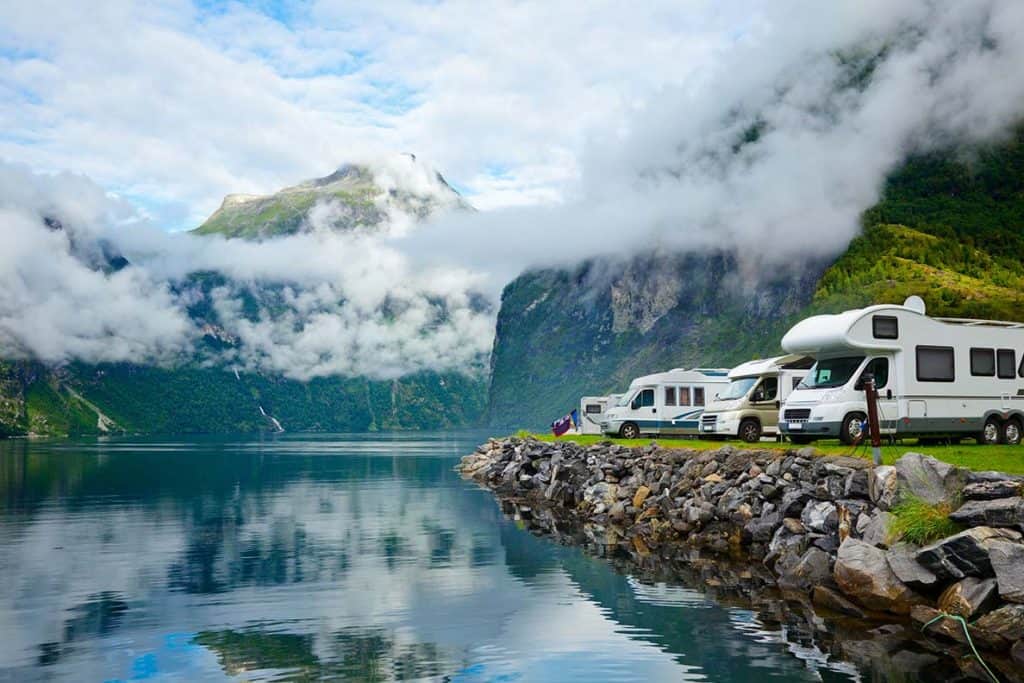
Øresund toll bridge- driving via Sweden
If you don’t want to take the ferry, the only other way to get into Norway with your vehicle is to drive via Sweden. This route is about 1580km from Calais to the Norwegian border and Google maps thinks it will take just under 18 hours (that’s probably very optimistic!)
The upside to this route is you don’t have to pay for a ferry. The downside is you have to pay for tolls on both the Øresund toll bridge and the smaller Storebælt toll bridge in Denmark.
When we went in 2018, the Øresund Bridge and the A/S Storebaelt cost us £275 one way.
Currently (2022), a 7m camper or motorhome (without trailer) costs 130€ (it can be cheaper if you pay in advance here.)
Storebælt toll bridge- 2022 prices for a motorhome between 6-10m (without trailer) and under 3.5tonnes is 75€
Other motorhome and campervan routes into Norway
Of course, if you have a couple of months, you can get into Norway from another direction. Perhaps you choose to drive up through Sweden, then enter up at the North and drive south through Norway.
Or you could even go via Poland, Latvia and Finland and make it a proper Scandanavia motorhoming adventure!
Norway Border Control/ Customs
Norway is not in the EU and therefore there IS a hard border between it and its neighbouring countries (unlike much of Europe.)
With this in mind, you are only allowed to carry over a certain amount of alcohol and tobacco, even if it’s for personal use- see the current allowances here.
You also need to complete a customs declaration form before you enter the country (which we only discovered at the ferry port and had to hastily complete. One of the funniest things was watching people who didn’t realise there was an alcohol allowance- they decided to make a party of it and were giving away their alcohol (and drinking as much of it as they could!)
Norway Customs app
By far the easiest way to declare and pay any customs charges is via the Norwegian Customs app. You can download it onto your phone/ iPad, fill it in, pay anything owed and then you can use the green channel when you arrive in Norway.
Expect your motorhome to be stopped and searched and have your paperwork ready. Don’t forget about dog paperwork too
Hiring a motorhome to tour Norway
If you don’t have your own vehicle, or don’t have time to drive to Norway, there are plenty of hire companies who rent out motorhomes or campervans. Expect to pay around £700 to £1000 a week for a small vehicle and go up from there. Prices are much cheaper in winter than in high season.
Of course, if you’re hiring a motorhome, you’ll have other factors to consider. If you’re flying in, you’ll need to pick an airport near the area you want to explore. Then you’ll need to find a hire company with a base near there and plan how to get from the airport to the campervan. If you want to do the North of the country, Tromso is a great starting point. For the south, Oslo or Bergen might work well for you.
Essential kit to carry when motorhoming or campervanning in Norway
In Norway, as with most countries in Europe, there are certain things you need to carry with you in your motorhome or campervan- although Norway is not as strict as many of the other European countries.
Don’t forget, if you are driving through other countries in Europe (which you probably will be, you need all the required kit for THOSE countries, as well as the stuff for Norway. If you’re used to motorhoming in France, you’ll already have everything you need.
Don’t forget to grab your FREE Europe motorhoming checklist below
Things you need to drive in Norway- safety gear
There are some safety items you should carry:
TOP TIP: Buy these essentials for driving in Europe BEFORE you get to the border- prices at Eurotunnel or on the ferry can be two or three times as much. Here’s what you need from Amazon, which is cheaper than Halfords or the high street.
Road trip accessories you MIGHT need for a motorhome holiday in Norway
Winter / All season / studded Tyres
Norway requires different tyre tread depths between summer and winter. If you are planning your road trip in Norway between 01 November to the first Sunday after Easter Monday (inclusive), the required tread depth is at least 3 millimetres.
In Nordland and Troms og Finnmark, the requirement for a tread depth of at least 3 mm applies from 16 October to 30 April (inclusive.)
At all other times, tyres are required to have a tread depth of at least 1.6 millimetres.
The vehicle must have winter tyres (studded or non-studded), chains or similar also outside of the periods mentioned above if this is necessary in order to ensure sufficient road grip.
If studded tyres are fitted to a car/ van weighing under 3.5 tonnes, they must be fitted to all four wheels. Vehicles with a permitted total weight of 3.5 tonnes or more must carry snow chains if ice or snow is expected. These snow chains must fit the vehicle’s wheels.
The cities of Trondheim and Oslo have a fee for city centre driving with studded tyres, in order to limit the pollution produced by studded tyres.
Snow chains
If you’re travelling Norway in a motorhome in winter, you will need to carry snow chains. You may be asked to show these at the border and even asked to demonstrate that you know how to fit them. If you don’t have any, you will be asked to purchase a set.
Get a full list of the essential kit and paperwork needed for motorhome touring in Norway and Europe
What documents do you need to drive in Norway?
If you’re motorhoming in Norway, you need to carry the following documents:
- Passport (or identity card)
- Driving licence (check it is in date!)- Yes, you can use your UK one.
- Motorhome Insurance documents- check you are covered for driving in Europe
- Breakdown cover
- Vehicle V5 logbook (which must show your correct address)
- Vehicle must be legally taxed and MOT’d
- Trailer certification
- Green card (get from your vehicle insurer)
- International Driving Permit if required
- Personal travel insurance
Do I need an international driving permit to drive in Norway?
Most UK citizens do not need an IDP to drive in Norway, as long as you have a card driving licence issued in the UK (in date, of course!)
You might need one if you have:
- a paper driving licence only
- a licence issued in Gibraltar, Guernsey, Jersey or the Isle of Man
(If you do need an IDP, here’s an in-depth guide on how to get an International Driving Permit and which one(s) you need from a UK post office.
Motorhome touring in Norway- Other useful things you might need
We’ve been touring Europe in our motorhome for several years. We’ve tried all sorts of kit- some useful, some not so much.
Here is a list of things we highly recommend when motorhoming in Norway, but which are NOT essential:
Campervanning in Norway – motorhome overnight stopovers and parking
Norway is very welcoming to motorhomers and campervanners. There are plenty of places to stay- both paid and free and they have a wonderful freedom to roam law- we’ll get to that shortly.
Motorhome campsites in Norway
Campsites in Norway are much like campsites anywhere else in Europe. There is a good network of campsites and they’re often quite rustic (although the one we stayed at had amazingly clean and modern toilets and showers,) but there was no bar or restaurant or communal areas. (Expect to pay extra to use the showers at many campsites.)
In the three weeks we spent touring Norway, we only stayed in a motorhome campsite once- partly because we wanted to use the laundrette, and partly because…well, just LOOK AT THE VIEW!
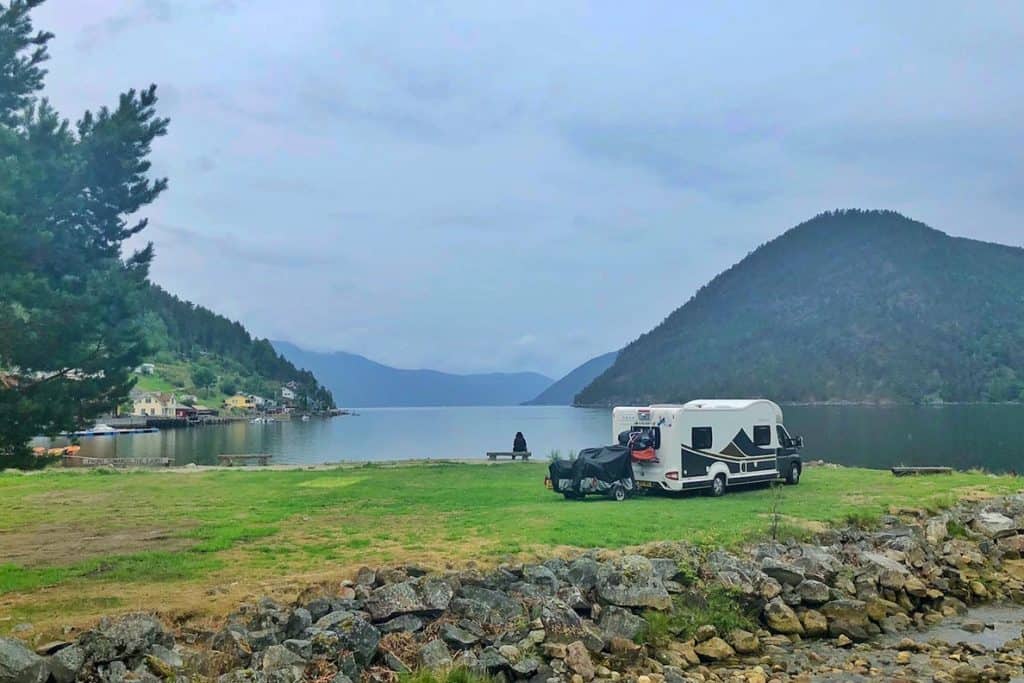
Even with the rain, it was still amazing. You can find out everything about this campsite in Norway here. It cost us 250NOK (at the time that was about £25) to stay without electric. The washing machine was 40NOK per wash- all other facilities were included.
If you’re travelling out of high season and are planning to use campsites, we highly recommend buying an ACSI CampingCard membership– you’ll save a lot of money as we found the campsites in Norway to be quite expensive. But if you’re happy to stay off-grid, save your money and go wild camping.
Aires in Norway
As well as campsites and wild camping, there is a network of aires in Norway.
An Aire is an approved motorhome and campervan overnight parking place, usually provided and maintained by the local town or village council. They often cost a few £ (or NOK) to use them overnight, although you will find some in more remote areas which are free to use overnight. Many of them have motorhome service points- often for a small additional fee.
If you’re touring Norway with a caravan, rejoice! Unlike most of Europe, caravans are welcome on aires.
READ MORE: Discover how we find and use Aires and overnight parking places when motorhoming in Europe
Wild camping in Norway for motorhomes and campers
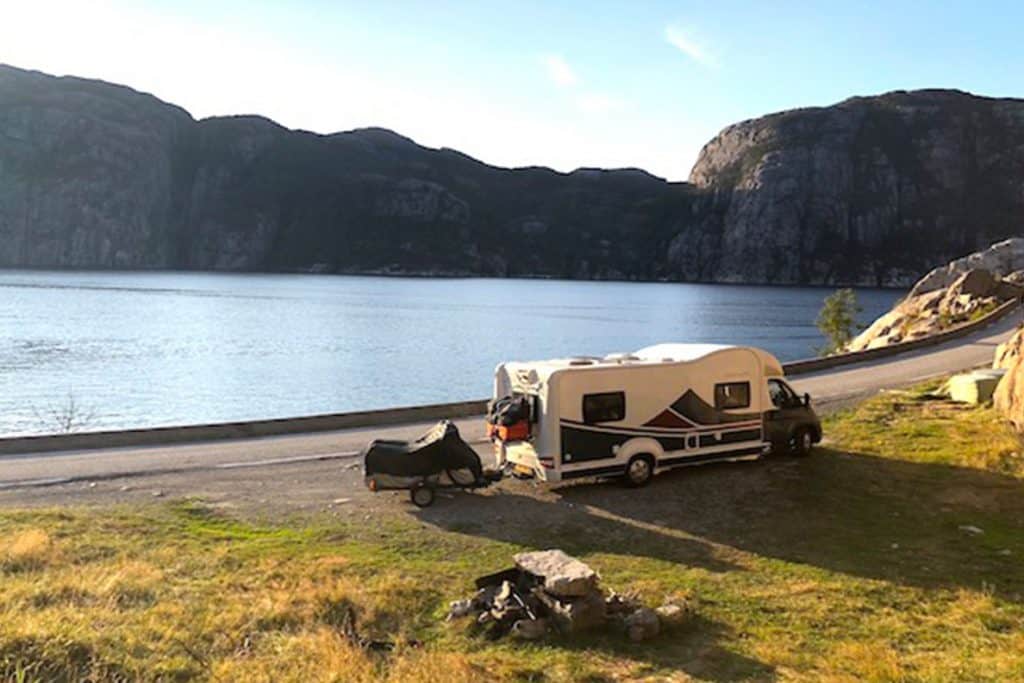
Ok, this is one of the best parts about motorhome travel in Norway- the FREEDOM and the right of access.
If you enjoy staying off-grid and wild camping with your motorhome, Norway is going to be your heaven. It has a freedom to roam law, allemannsrett (all man’s rights) meaning you can wild camp anywhere where the land is not owned, cultivated or where there is a sign forbidding it. We thought motorhome wild camping in Scotland was good, but Norway is better.
You need to follow these rules:
- Stay at least 150m from dwellings
- Stay no longer than 48 hours in one place
- Don’t stay if there is a sign stating no overnight parking
- Don’t put out awnings, chairs and so on- that’s ‘camping’
- Be vigilant about campfires in summer
Motorhome and campervan service points in Norway
Norway is an incredibly clean country free from litter and we urge anyone campervanning in Norway to keep it that way.
There are plenty of rubbish bins, dump stations and water taps almost everywhere. We found them using the Park4night app. Most rest areas had free toilets to use if you wish.
There was only one area where we needed water and couldn’t find it- near Flam- and the mean man at the campsite wouldn’t let us pay to fill up our tank. But otherwise, it was very easy.
At some of the motorhome service areas (Tømme stations) you might need a key from the garage or attendant, especially if using the black waste.
I don’t think we found any taps which WEREN’T drinking water- pretty much all the water in Norway is potable- and is provided freely, so there’s no need to buy bottled water. NOTE: In winter, some water supplies may be turned off at times if the supply might freeze.
Most running water in the mountains and forests of Norway is clean enough to drink, but avoid water running through pastures or runoff from glaciers, as this may contain harmful microorganisms.
Driving tips for Norway
We enjoyed driving in Norway. The roads are much less congested than the rest of Europe, and there’s so much space to spread out and explore. The tolls, tunnels and ferries take a little while to get used to- we’ll go into those in more detail shortly.
Norwegian drivers are pretty calm and happy to wait or give way as necessary. Roads are generally well maintained and roadworks are few, but there are some very narrow roads, especially along the edges of the fjords.
You’ll need to get used to how wide your motorhome is- and get used to other vans and lorries coming at you on very narrow roads. The scariest one was down a tiny tiny track- you can watch it at the end of this video:
We hope you found the video useful. If you did, we’d love it if you followed us on Youtube. New videos with tips for motorhoming and campervanning in the UK and Europe are released weekly.
Be aware of the weather conditions- the mountains can turn hostile very quickly in bad weather. Some mountain passes could close with no warning in inclement weather.
And pay attention to your brakes- going up and down mountain passes can make them very hot… and they could fail like they did on us in Switzerland! To avoid this, drive in a low gear, don’t ‘ride the brakes’ and brake with less force to help the brakes stay cool. (Read more about motorhoming in Switzerland)
When driving uphill, watch the vehicle’s temperature gauge to avoid engine overheating. If you’re planning to go up (or down!) Trollstigen (and you should!) choose your time wisely!
Also, don’t overestimate how far you can travel in one day. The roads are much slower than you might be expecting- not helped by all the ferries between places. It takes around 30 driving hours to go from Oslo up to Lofoten, so plan accordingly.
Here’s an overview for Norway driving rules:
- Norway drives on the right, so stay right and let them overtake on the left.
- You must drive with dipped headlights ALL THE TIME- even on sunny days
- Speeds are in kms- you might want to adjust your motorhome sat-nav settings
- Seatbelts and child safety seats are compulsory
- Using a mobile phone while the engine is on is illegal
- UK driving licences are perfectly acceptable to use and you probably won’t need an IDP (find out the changes made to driving in Europe after BREXIT)
- In cities where there is more than one lane, you’ll often find one reserved solely for buses and taxis- don’t use this!
- Traffic joining from the right has priority on junctions with no ‘give way’ signs or painted lines across the junction
- Passing places on single-tracked roads are marked by a white M on a blue background
- There are no restricted emissions zones in Norway, although central Oslo does close to diesel traffic when monitored emissions are considered high.
- Norway has a “human-oriented” culture which puts pedestrians and cyclist first. Pedestrians will expect you to slow down or stop so they can cross the street, and cyclists may not always follow traffic regulations!
Speed limits in Norway
The speed limits are low- another reason you won’t get anywhere as fast as you want to.
Speed Limits are as follows (unless otherwise signed!)
- Motorways/ major dual carriageways- 110km/h (70mph)
- Built up areas- 50 km/h (31 mph)
- Residential areas can be as low as 30 km/h
Speed limits for Vehicles over 3.5 tonnes and/ or towing
Heavy vehicles (over 3.5 tonnes) may not exceed 80 kilometres per hour regardless of the local limit- EXCEPT for motorhomes (camping cars) up to 7.5 tonnes, which are allowed to follow the same speed limits as other vehicles.
Vehicles towing caravans or trailers may not exceed 80 kilometres per hour regardless of the local limit. If the caravan or trailer is not equipped with brakes, the maximum speed is 60 kilometres per hour.
Speed Cameras in Norway
Yep, they have them. Frequently. They are often on bridges but police also do manual checks which can lead to on-the-spot-fines.
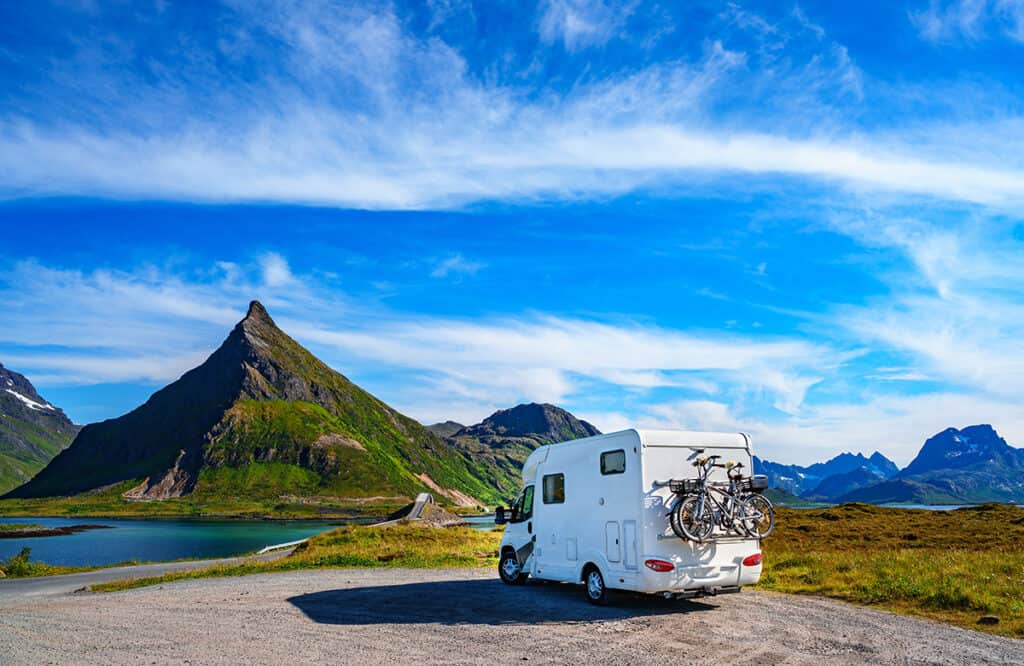
Drink Drive law in Norway
Alcohol laws are very strict in Norway, and penalties from driving under the influence are severe. The legal limit is 0.02% blood alcohol (the UK is 0.08%) and applies to the driver of any motorised vehicle. Medications to avoid if you intend to drive are marked with a red triangle.
Tolls in Norway
If you’re used to motorhoming in Germany or the UK (where there are very few tolls), Norway is going to be a shock.
There are about 200 toll stations in Norway. All of which are automated, and marked with “AutoPASS” and the symbol to the right. Avoiding a toll often means driving hours out of your way AND taking 2 or even 3 extra ferries, so it defeats the point. On the plus side, motorhomes are charged the same price as cars and the total toll costs aren’t usually that high.
The tolls all use number-plate recognition, so before you drive in Norway with a foreign vehicle, you should register
How much are the tolls in Norway?
In total, we went through 23 tolls during our 3-week Norway road trip- and over half of those were on the E6, which is the main road running North-South through central Norway (‘I’ on the map). The cost of that 2-day trip was £84.88 in toll charges.
The other tolls in Norway (around the western edge) came to a whopping £20.06- not bad for 12 days driving! But these are the roads with all the ferries on, so we also paid ferry costs on top of those toll charges.
So the total toll charges for our 3 week Norway road trip was £104.94
How to pay tolls in Norway
There are two options to pay- either get a toll tag or be charged on the EPass24 scheme. On the Atlantic Road, it may be possible to pay manually, but everywhere else is payment card online after you’ve received your bill.
EPass 24 Scheme
Registration is optional, but if you register for an EPass24 account this will normally reduce the time elapsed from the journey until you receive an invoice AND will make sure you pay the correct tariff- failure to register could result in you paying higher charges.
- Register your foreign owned / rented / leased vehicle here
- Drive through the AutoPASS toll lanes without stopping.
- The invoice will be sent to you, based on the information that you have registered (by email if registered, by post if not)
- Pay the invoice online by payment card
Autopass Toll tag
However, if you’d like a discount (up to 20%) on your toll prices, get a toll tag.
These MUST be issued in advance- you cannot buy a toll tag for a private vehicle at the border.
Autopass is the name for the tolls, NOT the name of the provider. There are several providers to register with- visit the Autopass.no website and choose one.
We registered with BroBizz as we had a motorhome over 3.5t and they were very good. I’ve also heard good things about Flyt and Fremtind but not used them personally.
The biggest benefit of a toll tag is a discount, often as much as 20%!
Don’t forget, you MUST register several weeks before you leave so you have time to receive your toll pass in the post.
Ferries in Norway
Norway is full of water. There are fjords and islands everywhere. If you’ve ever been motorhoming in Holland, you might not appreciate the problem… until you realise that these fjords are surrounded by mountains and it’s not easy to build roads over them. So they use ferries. It’s no different from using a tunnel or toll road- just part of the road network in Norway.
The ferries in Norway are not like the ferries between the UK and France. You don’t have to book in advance and they don’t just go a couple of times a day. They’re like shuttles, going back and forth continuously all day (although many do shut for a few hours late at night/ early morning.
There are no ‘cabins’ or requirement to book seats- you stay in your vehicle or can walk around the deck enjoying the view of the fjords. Some ferries take only 20 minutes, others can take nearly an hour. You can see them on your map/ sat-nav.
How to use the ferries in Norway
They are really easy to use, even if they are expensive. You pull up, wait in the queue, a ferry employee either will walk down the line, ask you your length and charge you the fee (one-way). Sometimes you pay when you are onboard. You can pay by card or cash (NOK).
CAUTION: Some places have ferries going to 2 or more destinations. Make sure you line up in the correct queue or you’ll find yourself on a ferry in the wrong direction. Also, some ferries have a stop-off service, so they go to one place, and then another. Make sure you get off at the correct stop!
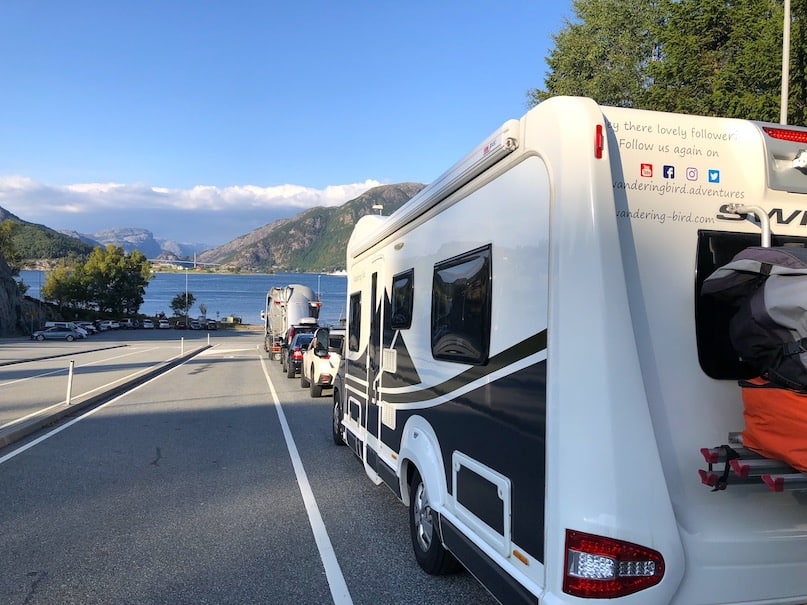
How much do the ferries in Norway cost?
The cost of the ferry depends entirely on your length… as we discovered when we turned up in a 7.8m motorhome towing a 3m trailer. Ouch. Did I mention touring Norway by camper was expensive…
If you are under 6m, you’ll pay the same price as a car, which is pretty reasonable. You can expect to pay around NKR100 for every ten minutes of ferry time in a sub-6m campervan or motorhome. The cost advertised includes the driver, then you have to pay for additional passengers.
For us, we paid (as a 7.8m motorhome with a trailer):
- Ferry from Luavika to Oanes 358NOK
- Ferry from Puntnes (hjelmeland) – Nesvik on 13 – 430NOK
- Ferry Skanevik- Utaker (48) – 438nok
- Ferry Arsnes- Gjermundshamn (DONT PANIC- it goes to the island Varoldsoyna first!!) – 534NOK
- Ferry Fornes -Mannheller (route 5) – 384NOK
- Ferry Stranda – Liabygda – 412NOK
- Ferry E39 Vestnes- Molde – 602NOK
- Ferry E39 Halsa- Kanestraum – 438 NOK
TOTAL = 3596 NOK (roughly £333.44 in 2018)
How to pay for the ferries in Norway
The ferries are not the same as Tolls. You need to pay as you go, using card or cash. We used our UK bank cards (Visa debit) without issue. They prefer card as they don’t always have change for cash.
Tunnels in Norway
Did I mention Norway is full of mountains and fjords? Often, instead of going over or round, they built the roads THROUGH- so expect to spend more time than you might expect in tunnels.
You’ll find some with roundabouts, slip roads, extreme inclines or declines and even rest stops- in the Laerdal Tunnel (one of the longest road tunnels in the world at over 15 miles long), those rest stops are blue! (If you don’t want to go through the tunnel, you can take the Aurlandsfjellet Tourist Route which runs over the mountain above it.)
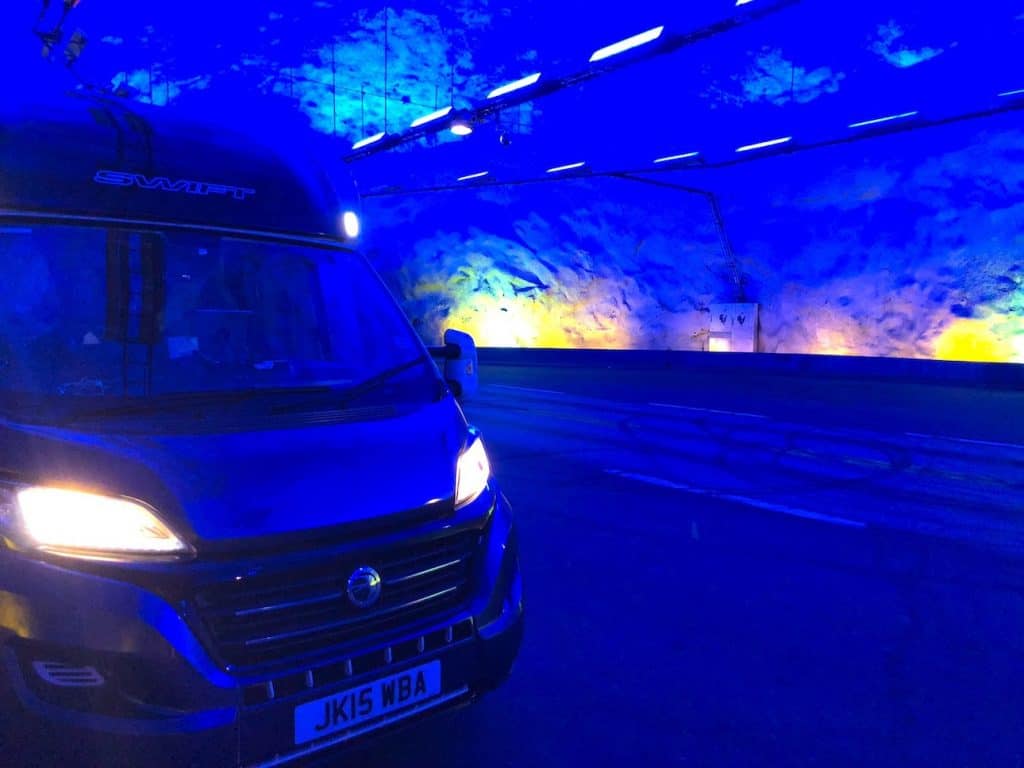
Petrol/ Diesel in Norway
Fuel prices in Norway are relatively high due to environmental politics. Fuel stations are fewer in the mountains and other remote areas, especially in Northern Norway.
Fuel also gets more expensive the further north you go.
Unleaded is called Blyfri It’s often super (95) or Super plus (98) – Green handles on pump
Diesel is… Diesel Black or yellow handles on pump
Some places are 24h pay at the pump, but may require you to go into the shop and pay the cashier either in advance or after you’ve filled up- there will be a sign to tell you what to do. (Leave your car in front of the pump and make a note of the pump number.)
You can pay using cash or a credit card. Many places do NOT take American Express. You can usually use your UK cards without a problem.
LPG in Norway
There are more than one hundred LPG stations across the country. Some are manned, some are automated and self-service. Some closed at night or on Sundays, others are 24 hours. You can find them using the website LPGnorge.no
Some used the UK bayonet connector, others the dutch bayonet. Many stations provide an “adapter” that will work regardless of your motorhome’s system. You can bring your own adapter if you want to.
You can watch us refilling our LPG in Norway here:
We hope you found the video useful. If you did, we’d love it if you followed us on Youtube. New videos with tips for motorhoming and campervanning in the UK and Europe are released weekly.
If using the MyLPG.eu website, check when the stations were last confirmed as being open (many are no longer there.)
Note: There is NO LPG in Finland, so if you’re planning your motorhome trip to include that country, top-up before you enter.
Driving in Norway- what to do in the event of a road traffic accident
You should have a European Claim Form provided by your insurer before you leave. In the event of an accident, all parties complete and sign the form at the scene and then send a copy to your insurer for assessment.
What to do at the scene:
- Stop your vehicle immediately but safely- out of the flow of traffic if possible.
- If a vehicle is blocking the road, use hazard lights and put the red warning triangle 30 metres from the scene to warn approaching traffic
- Exchange your details with the other involved parties. Be sure to get:
- Name and address of all the people involved in the accident
- Vehicle registration numbers of all parties
- Insurance company details of all parties
- Take photos of damage using a camera, GoPro or phone
For more details, read our step-by-step guide on dealing with a road traffic accident in Europe
Motorhoming in Norway- How expensive is it?
Norway is consistently rated as one of the top 3 most expensive countries in the world. Norwegians are well-paid, and also pay high taxes, but the general cost of living is crazy high.
If you’re motorhoming in Norway, the tolls, ferries, fuel and vehicle costs are offset by the lack of campsite costs (if you’re wild camping), but the biggest expense, apart from getting there, is likely to be food and drink.
If you’d like to see a complete breakdown of our motorhome trip to Norway, you can see exactly how expensive Norway is to road trip here.
Food and Drink in Norway
Food and alcohol are one of the most expensive things on any trip to Norway. One huge tip is to stock up in advance in Germany, Denmark or even Sweden. Remember the rules for taking alcohol across the border.
This is one of the biggest advantages to touring Norway with a motorhome or campervan- you can save a lot of money by taking and preparing your own food.
Norwegians love their food and have many local specialities. Seafood is always good, but you could find reindeer (reinsdyrstek), torsketunger (cod’s tongues), rakfisk (fermented trout) or a huge number of dried and cured meats and fish. Brown goats cheese (Brunost) is very common at meals.
Supermarkets/ shops in Norway
For the best prices in Norway, try and shop in the Spar or Co-op’s. There is no Lidl or Aldi in Norway (apparently, Lidl tried… and then gave up!)
Expect to pay at least double the amount you are used to in the UK for everything in a supermarket- even the local produce. Many stores have an ‘own brand’ which is slightly more reasonable- think Waitrose or M & S prices.
Most supermarkets and grocery shops do not open on Sundays. Garages will sell basic groceries (and hot dogs!) but at inflated prices!
All drinks (cans and plastic bottles) have a deposit (pant) on them- in addition to the price on the label. You can put them back into the machine inside the supermarkets and get the option of a voucher to spend or giving the money to charity.
Alcohol in Norway
Tax is charged on all alcohol with more than 0.7% volume of alcohol, making all alcohol expensive.
Beer can be found in most supermarkets, but is only sold before 8 pm on weekdays or 6 pm on Saturdays. For wine, spirits or strong beer, you must visit one of the Vinmonopolet outlets, found in most large cities and towns. To buy wine or beer in Norway, the minimum age is 18 years. For spirits, it is 20 years.
In a Vinmonopolet you will pay around NKR150 for a bottle of wine and NKR50 for beer and cider. Spirits cost considerably more.
Eating Out in Norway
I’ll be honest, the only eating out we did was pizza- and it was so good we had it twice! The prices of restaurant and takeaway meals is crazy- even a McDonalds can cost upwards of £10 for a meal. Burger and chips can be £25 per meal and a beer, cider or glass of wine in a restaurant will cost between NKR60-90.
More useful things to know when campervanning in Norway
Emergency Numbers: 112 will get you everything you need.
Language: Norwegian. English is widely understood and spoken flawlessly.
Currency: Norway uses the Norwegian Krone (NOK), NOT the Euro. Obviously, the exchange rate fluctuates, but as a very rough guide, 10 NOK is about £1.
Cards: most major credit and debit cards are accepted. American Express is only taken in large stores (not often at fuel stations)
Timezone: GMT+1 (or one hour ahead in BST) Norway is always one hour ahead of the UK, no matter what. Their clocks go forward and back whenever ours does.
Tipping– Tipping is not customary but always appreciated. It’s common to round the bill to the nearest 10NOK.
Touring Norway with a dog
Yes, you can take your dog into Norway. You will need to get a tapeworm tablet administered by a vet 1-5 days before arrival (just like when you return to the UK). And yes, you will need ANOTHER one to go into the UK after driving back through Europe.
Norway is pretty dog friendly. You must keep your dog on a lead when walking between 1 April and 20 August to protect wildlife. Apart from that, they are allowed almost everywhere, including on the beaches.
Using a drone in Norway
We love using our drone when we travel and Norway was wonderful for drone shots. Here are the regulations.
READ MORE: What’s the best travel drone (and how to choose)
Drones and similar remote-controlled flying devices must be kept at least a minimum 150m from people, vehicles and buildings that are not connected with the drone operator. Flying must happen in daylight only and up to a maximum height of 120m. Never fly closer than 5km to airports. The drone must always remain within the sight of the operator.
Please check for local regulations and military or other special restricted areas where all the aforementioned activities are forbidden by law. Read more about using drones in Norway on the Norwegian CAA website.


